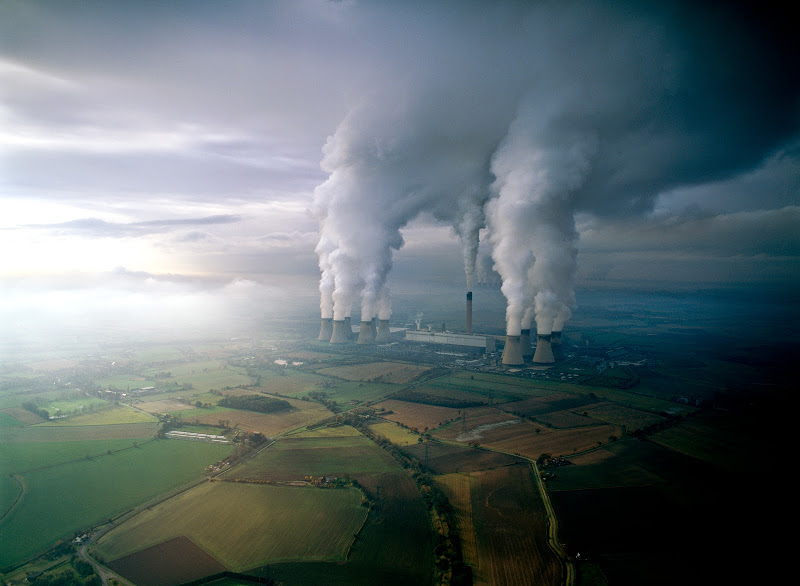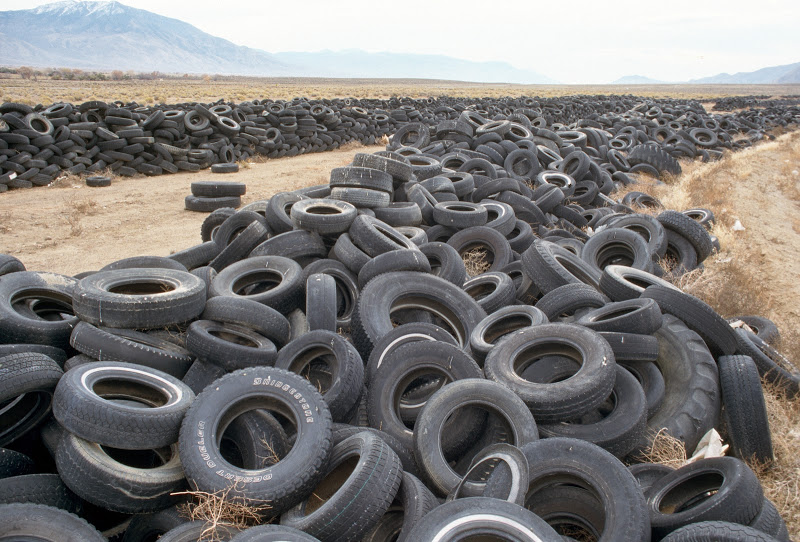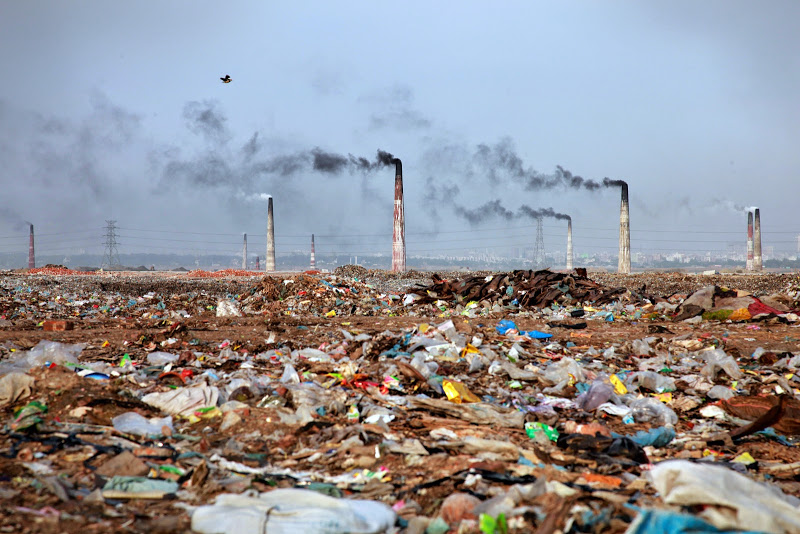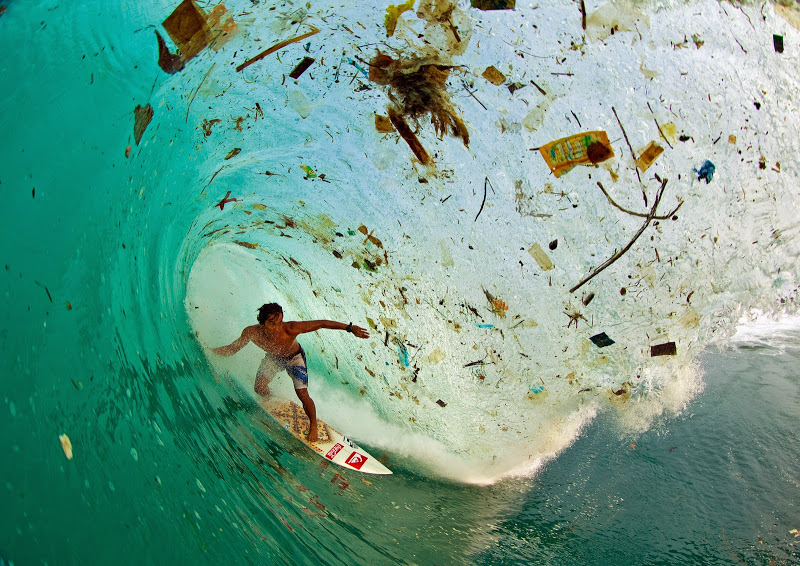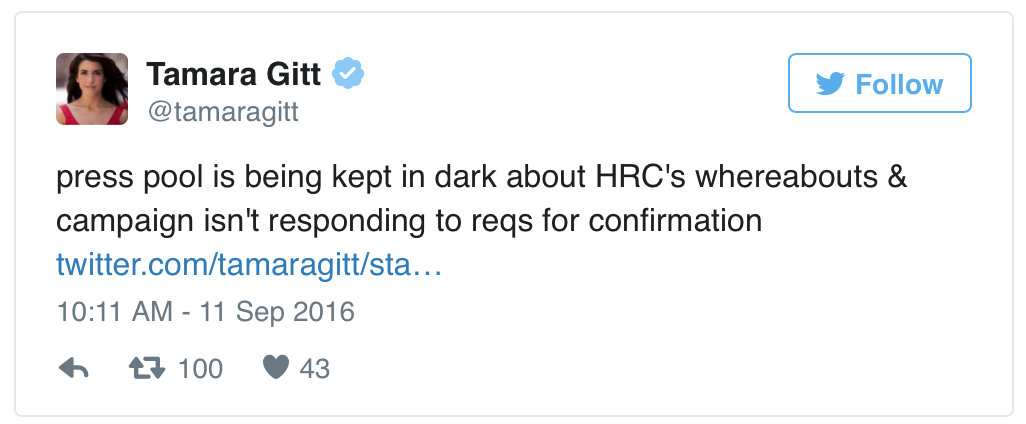This article was originally published on Global Research in April 2011:
One of the most divisive arguments within the environmental movement is population growth, whether by increasing births, or via immigration.
But population figures conceal more than they reveal. They seem to suggest that the cause of climate change is too many people, and that a growing population means growing greenhouse gas emissions. Therefore, we should encourage people to have smaller families because it’s “a lot easier than retooling our economic system.” (1) And further, that we must slow population growth where it’s greatest, e.g. the “Third” World, where population is “exploding.”
In Chapter Three of his “Spaces of Capital: Towards a Critical Geography,” David Harvey gets to the bottom of this argument by dissecting the three pillars on which it stands – subsistence, resources, and scarcity.
The argument first posits an absolute and unchanging subsistence level, the bare minimum people need to stay alive. But this level has been defined differently over time, according to the society in which people were living. The subsistence level in Europe’s Dark Ages was defined very differently from that in the European Union today. And today’s subsistence level is defined very differently in Uganda than it is in the United States.
This argument further categorizes nature as a “supermarket” of resources available to be made useful to humans. But this perception has also varied according to the level of historical, technological, and cultural development within particular societies.
The third absolute in this argument is scarcity, defined as intrinsic to nature. But this, too, is rooted in views of particular societies and modes of production. Societies seek particular goals/ends, and it’s these goals/ends and the means used to achieve them, as much as a lack of natural resources, that define, even manufacture, scarcity.
Much scarcity is, in fact, created by the activities humans choose to engage in, according to the way their societies have been organized. The scarcity of available land in cities like New York and London is a result of human activity, not nature’s. And if this scarcity were not manufactured, the rents in London and New York would not be so wildly lucrative.

In such a scenario, a “crisis of overpopulation” happens when the scarcity of available resources no longer meets the subsistence needs of most of the population. In other words, there are too many people in the world to allow “us” to continue to live in the way in which we’ve organized our society, based on available natural resources that we could be using to continue to live the way we’ve been living – if only it weren’t for all those people making subsistence demands and potentially preventing us from living in the way to which we’ve become accustomed. (Think “non-negotiable American way of life.”)
But there are things we could do to change this scenario and adapt, which has been the hallmark of our species across millions of years. We could redefine our goals by changing the societal organization that creates scarcity. We could change our view of nature as a resource supermarket with value only insofar as we can make use of it. We could change the things to which we’ve become accustomed. Or we could try to reduce the number of people with subsistence needs to be met.
All of these options would be explored in relation to each other if there were real concern with environmental issues.
But it’s easiest by far to focus on population, especially other people’s population, and further, their overpopulation in view of the “scarcity” of resources we’ve created as a result of the way we’ve organized our society and how we go about implementing its goals.
“Somebody, somewhere is redundant, and there is not enough to go round. Am I redundant? Of course not. Are you redundant? Of course not. So who’s redundant? Of course, it must be them. And if there’s not enough to go round, then it is only right and proper that they, who contribute so little to society, ought to bear the brunt of the burden.” “And if we hold that there are certain of us who, by virtue of our skills, abilities, and attainments, are capable of ‘conferring a signal benefit on mankind’ through our contributions to the common good and who, besides, are the purveyors of peace, freedom, culture, and civilization, then it would appear to be our bound duty to protect and preserve ourselves for the sake of all mankind.”(2) (emphasis added)
The population growth argument starts and ends with one idea – Earth with lots of people is bad, and Earth with more people is worse. The argument goes that one person’s carbon footprint is X, two people’s, 2X, three people’s, 3X, and so on. In this way we arrive at the conclusion that the effect of population on the environment is proportional to the number of people.
The whole of a country’s emissions are represented as the sum of each person’s, or per capita, emissions. This makes it look like total emissions are a function of the total amount of people in that country. But unless you know before hand what the total emissions are, you cannot calculate per capita emissions. Per capita emissions can only be determined when total emissions are already known, not the other way around. Total emissions are not arrived at by adding up each individual’s contribution.
Per capita is simply total emissions divided by total population. The total remains the same whether every individual creates an equal amount of emissions, or one person generates them all. It’s impossible to tell how much of the total each individual is responsible for when only the total is known. Per capita reveals nothing about individual contributions.
In the US, each individual’s per capita share includes a share of the emissions created by commercial air travel, the extraction of coal, oil and natural gas, factory farms, the military, and the manufacture and use of pharmaceuticals and oil-based fertilizers and pesticides. If one-third of the population of the US moved to Canada overnight, the per capita share of the remaining population would shoot up in the US and fall in Canada without any change in individual consumption or total emissions having occurred overnight in either country. But US citizens would still be held responsible for the rise in per capita emissions which was created primarily by industry.
So that per capita math magic, those numbers examined in a vacuum, tell us next to nothing, and need to be looked at in context. Ian Angus did just that with his article, “Dissecting Those ‘Overpopulation’ Numbers.” In “Part One: Population Where?” he worked with actual global population and emissions figures for 2006 – and shredded the “more people equal more pollution” argument with the facts.
The population growth argument ignores what the total fertility rates in the G-20 countries, which describe themselves as “the systematically significant industrial and emerging-market economies,” and the total fertility rates in the world’s nineteen countries with the lowest levels of CO2 emissions illustrate.
The total fertility rate is the average number of children each woman in a country will have in her lifetime. The higher this number, the faster the population is growing. A stable population, that is, one that’s neither growing nor declining, has a total fertility rate of about 2.3 children per woman.
In the G-20 countries, which generate 90% of the world’s Gross National Product, this rate is as low as 1.21. The G-20 includes Argentina, Australia, Brazil, Canada, China, France, Germany, India, Indonesia, Italy, Japan, Mexico, Russia, Saudi Arabia, South Africa, South Korea, Turkey, the UK and the US. (The “twentieth” is the European Union.)
In the world’s nineteen countries with the lowest CO2 emissions, however, the total fertility rate is as high as 7.75. All of these countries, with the exception of Afghanistan, are in Africa. They include Burkina Faso, Burundi, Central African Republic, Chad, Democratic Republic of Congo, Eritrea, Ethiopia, Guinea, Madagascar, Malawi, Mali, Mozambique, Niger, Rwanda, Sierra Leone, Somalia, Tanzania, and Uganda.
Let’s contrast total fertility rate with total CO2 emissions per country for 2006. These range from a high in China of 6103.49 million tonnes* to a low of 273.71 million tonnes in Turkey. The G-20 total was 22566.76 million tonnes. (*These are British ‘long’ tons.) The nineteen countries with the lowest rate of CO2 emissions range from a high of 6.01 million tonnes in Ethiopia to a low of 0.2 million tonnes in Burundi. Their total was 29.3 million tonnes. In other words, the countries with the lowest population growth rates are producing the bulk of C02 emissions, more than a whopping 770 times as much as the nineteen countries with the highest rates of population growth.
Angus has done the math. Per capita, each American’s CO2 emissions were 132 times more than a person’s in Madagascar, 197 times more than a person’s in Mozambique, and 400 times more than someone who lived in Mali or Burkina Faso. And these amounts don’t include the concentration of CO2 emission sources in G-20 countries like their militaries, extractive and agricultural industries, and commercial air travel.
Total emissions do not depend on population density. The high-emitting G-20 includes densely-populated countries like Japan and India, but also the sparsely-populated countries of Canada and Russia. This is equally true of the nineteen countries with the lowest emission rates. Rwanda and Burundi are densely populated. Chad and Niger are not. So it’s obvious that low population density can co-exist with high emissions, and high population density with low emissions.
If emissions are dependent on population density, it would appear that high emissions cause low population growth (G-20), or that high population growth causes low emissions (the nineteen countries with the lowest rates of CO2 emissions). These statements are equally absurd. Both population growth and CO2 emissions depend on socioeconomic factors, not biological ones.
So there’s something not right about the “more people cause more emissions” argument, and something very wrong with promoting the idea that birth control for the “Third” World will slow climate change. Focus on population growth distracts attention from issues like production and consumption, policies of technology and globalization, poverty and women’s status in world societies, and the boom and bust of our economic system’s cycle itself. But the population control argument keeps reappearing as the solution to poverty, hunger, and now climate change. The simple theory: more people equal more pollution.
In “Peoplequake,” Fred Pearce makes the point that the poorest three billion of us emit only 7% of CO2 worldwide, while the richest half billion of us create 50% of them. (There are 6.9 billion of us.) He says that a woman in rural Ethiopia with ten children does less damage, and uses fewer resources than one middle class family of four in the US, the UK or Germany. And even if all ten of that Ethiopian woman’s children reach adulthood, which is highly unlikely, her entire extended family of over 100 people would still emit only about as much CO2 every year as one American.
So to suggest that the greatest threat to escalating climate change is too many children in Ethiopia, Somalia or Uganda is both disingenuous and dangerous. The population “bomb” of the 20th century has been defused. In fact, the rate of global population growth is slowing down. According to the US Census Bureau International Data Base (December 2008), it peaked in the 60s and has fallen consistently ever since. Yet the rate of greenhouse gas emissions is skyrocketing out of control. Some however, continue to claim this increase in emissions is a function of population growth, though the rise in energy and resource use has vastly outstripped population growth.
In September of 2009, the journal “Environment and Urbanization” showed that the places where population is growing the fastest are those where carbon emissions have been growing most slowly. Between 1980 and 2005, 63% of the world’s population growth took place in countries with very low emissions. (3)
But by the end of the 60s, “reducing the population growth of poor countries had become an essential element of US foreign policy. The main motive was not environmental: rather, population growth was seen as retarding economic growth and fomenting political instability, making countries more susceptible to Communist influence.” (4)
Detailed population growth statistics are easily available. This allowed population control advocates to place them side-by-side with rising pollution statistics and draw a biological conclusion. They divided the total pollution by the total population and came up with an individual, per capita, “carbon footprint” for every person on Earth.
So overconsumption and transnational corporate plunder were swept under the rug and the wombs of poor women became the reason for deforestation, water pollution, and desertification. This diverted the environmental movement and shifted blame to the “Third” World, allowing the countries of the “developed” world to avoid looking in the mirror at their own consumption and that of their governments, their militaries, and their transnational corporations, which were trashing the environment both at home and abroad.
The population growth argument is just old wine in a new bottle. Those who advocate population control are pretending to address climate change so they can avoid focusing on replacing fossil fuels with renewable energy. They prefer to believe there’s a biological solution to problems created by the way society is structured. Population growth has been made the scapegoat for the real social and economic causes of “poverty, hunger, famine, disease, war, racism, and unemployment.” (5)
But population control has never had an acceptable environmental outcome. Witness China. “China’s one child policy has been hailed as an environmental measure… (but this)…ignores that China’s population control has hardly solved that country’s growing environmental problems.” (6)
Population control is a euphemism for eugenics. It employs “us vs. them” in order to blame those least responsible for climate change by focusing on the quantity of human beings, rather than on the quality of their lives, when, in fact, it’s not so much the what of those population numbers, but the how of the way those numbers live that matters. Those most responsible for the escalating threat of climate change are those who profit most from polluting and poisoning, and they’re desperately resisting change. (7) That’s because they know that most greenhouse gases aren’t caused by individuals, but “by industrial and other processes over which individuals have no control.” (8)
Ian Angus and Simon Butler have pointed out that no reduction of Canada’s population (via fewer births or curtailed immigration) would have any effect on the oil industry’s extraction of oil from the Alberta Tar Sands. Neither would such reductions in the US have any effect on the massive military spending of the Pentagon, the world’s number one oil consumer.
They further assert that there is no means of reducing population that will change either of those things. In fact, reducing the population would have the effect of increasing the per capita emissions of the remaining population. You just get a larger number (or individual carbon footprint) when you divide the reduced population into the same total emissions output.
The anti-immigrant wing of the population control argument says it’s better to keep poor people in poor countries so they consume less (and we can continue to consume more) than if they came “here” and adopted “our” lifestyle. In 1974, Garett Hardin’s essay “Lifeboat Ethics” suggested throwing the poor majority overboard to allow the “elite” to survive. He blamed immigration for “speeding up the destruction of the environment of the rich countries.” This just diverts attention from the threat to the environment of overconsumption. For instance, US consumers, with only 5% of the world’s population, use 20% of the world’s resources.
Anti-immigrationists claim that immigrants will consume a lot more energy in the US than if they stayed in their home country, so they and their families are responsible for growing carbon emissions. So instead of conserving energy, switching to renewables, and adopting a sensible climate policy, we should just build bigger fences and continue to burn fossil fuels, which sustain not only that non-negotiable American lifestyle, but the escalating degradation of the environment. (9)
Both the immigration and population-growth wings of the populationist argument have only one “solution” – STOP!!! Either stop immigration or stop population growth. But climate change is a socioeconomic and political problem, not a biological problem. And because of the way in which the globalized economic system is structured, it doesn’t matter how many people there are. The environment will continue to be beaten down, and inequality will continue to be ratcheted up as a result of the way the dominant peoples on the planet have chosen to organize their societies and go about achieving their goals.
“Blaming climate change on human numbers is itself founded on denial – denial of the real causes of the problem and denial of our potential to forge positive solutions.” “Instead of buying into the ‘more people=more emissions’ equation, we should put the blame for climate change squarely where it belongs: on fossil fuels and the vested interests that seek to perpetuate dependence on them.” (10)
These vested interests have the power to shift the true cost of their environmental and social degradation onto society as a whole, simply by ignoring their toxic waste. It’s easier to just pour it into the air, into rivers, and discharge it along deserted rural roads by night. Society pays the real costs of production, or “externalities,” by cleaning up the mess, or by enduring its effects and its costs on both the environment and health. And if pushed, the vested interests just export their externalities en masse to the “Third” World. (11)
“Many of the emissions for which poorer countries are blamed should in fairness belong to us. Gas flaring by companies exporting oil from Nigeria, for example, has produced more greenhouse gases than all other sources in sub-Saharan Africa put together. Even deforestation in poor countries is driven mostly by commercial operations delivering timber, meat and animal feed to rich consumers.” (12)
The estimated damage to the environment in 2008 by the “externalities” of the 3,000 largest public companies in the world topped $2.2 trillion, more than the economies of all but seven countries in the world. The heads of major corporations at the 2010 economic summit in Davos, Switzerland, were worried about the effect on their bottom lines if they have to stop damaging the environment, or if they are forced to pay for the pollution they create. (13) They were not, however, worried about environmental damage or the effects on human health of continuing to pollute with impunity.
“Keeping fossil fuels in the ground will mean defeating the world’s most powerful corporations and institutions.” (14 ) “Rather than rise to this challenge, populationists fear that it’s too difficult.” (15) Population control has one big advantage: it seems easier.
In 2009, Ross Gittins wrote in the Sydney Morning Herald that “Since the rich countries are reluctant to countenance a decline in living standards, to put it mildly, and the poor countries most assuredly won’t abandon their quest for affluence, there’s one obvious variable that could be used to limit global economic activity’s deleterious impact on the ecosystem: population growth.” “Limiting population growth in the developing world and allowing population to continue on its established path of decline in the developed world wouldn’t be easy, but it would be easier than trying to prevent rising living standards among those already living.” (emphasis added)
He links “serious action on climate change with a ‘decline in living standards’ – as if a high quality of life depends on trashing the planet.” (16)
Katie McKay Bryson, who coordinates the US-based Population and Development Program asks “Why is it easier for those who use and waste the most to imagine fewer people than less stuff?”
Population control shifts the focus off changing the social status quo. Rather than adapting to change, population control advocates prefer to make people the problem, particularly other people. But people are the solution. We exist on Earth today because people adapted to change. People who are willing to change are the key to continued human existence on the planet.
Vi Ransel is a frequent contributor to online political newsletters. She can be reached at [email protected].
NOTES:
(1) Hayden. Thomas. “Environmental books suggest save-the-Earth Climate may be entering a new phase,” Washington Post, 4/20/10.
(2) Harvey, David. “The Political Implications of Population – Resources Theory,” Spaces of Capital: Towards a Critical Geography,” Routledge, 2001.
(3) Satterthwaite, David. “The Implications of Population Growth and Urbanization for Climate Change,” Environment & Urbanization, Sept. 2009.
(4) Hartmann, Betsey. “The Greening of Hate,” Special Report: Southern Poverty Law Center,” 7/20/10.
(5) Butler, Simon. “Population Control: 10 Reasons Why It’s the Wrong Answer,” Green Left Weekly, 5/30/09.
(6) Butler, Simon. Ibid.
(7) Butler, Simon. Ibid.
(8) Angus, Ian, and Butler, Simon. “Should Climate Activists Support Limits on Immigration?” Climate and Capitalism, 1/24/2010.
(9) Hartmann. Ibid.
(10) Boyce, James K. “Climate Change: Are People the Problem?” TripleCrisis.com, 7/6/10.
(11) Townsend, Terry. “Individual Versus Social Solutions to Global Warming,” Links, 4/17/08.
(12) Monbiot, George. “The Population Myth,” Monbiot.com, 9/29/09.
(13) Jowitt, Juliette. “3,000 Companies Cause $2.2 Trillion in Environmental Damage – Every Year,” The Guardian, 2/18/10.
(14) Boyce, James K. Ibid.
(15) Butler, Simon. “Population Control – A Political Weapon for Conservatives,” Green Left Weekly, 6/24/10.
(16) Butler, Simon. Ibid.
BIBLIOGRAPHY:
Angus, Ian. “Dissecting Those ‘Overpopulation’ Numbers. Part One – Population Where?” Climate and Capitalism, 4/28/10.
Angus, Ian. “Dissecting Those ‘Overpopulation’ Numbers. Part Two – The Perils of Per Capita,” Climate and Capitalism, 7/2/10.
Angus, Ian. “Dissecting Those ‘Overpopulation’ Numbers: Appendix to Part Two: Rate versus Ratio,” Climate and Capitalism, 7/27/10.
Angus, Ian. “Do Consumers Cause Climate Change?” Climate and Capitalism, 2/20/10.
Angus, Ian, and Butler, Simon. “Should Climate Activists Support Limits on Immigration?” Climate and Capitalism, 1/24/2010.
Berkowitz, Bill. “Right Wing Front Organizations Use Progressive Sounding Names to Promote Anti-Immigration and Anti-Environmental Agendas,” The Smirking Chimp, 7/23/10.
Boyce, James K. “Climate Change: Are People the Problem?” TripleCrisis.com, 7/6/10.
Butler, Simon. “Population Control – A Political Weapon for Conservatives,” Green Left Weekly, 6/24/10.
Butler, Simon. “Population Control: 10 Reasons Why It’s the Wrong Answer,” Green Left Weekly, 5/30/09.
Conner, Steve. “We need a global debate on population,” The Independent, 7/14/10.
Hartmann, Betsey. “The Greening of Hate” Special Report: Southern Poverty Law Center, 7/20/10.
Harvey, David. “The Political Implications of Population – Resources Theory,” “Spaces of Capital: Towards a Critical Geography,” Routledge, 2001.
Hayden, Thomas. “Environmental books suggest save-the-Earth Climate may be entering a new phase,” Washington Post, 4/20/10.
Hildyard, Nicholas. “Too Many for What? The Social Generation of Food ‘Scarcity’ and ‘Overpopulation’,” The Corner House, 11/1/96.
Jowitt, Juliette. “3,000 Companies Cause $2.2 Trillion in Environmental Damage – Every Year,” The Guardian, 2/18/10.
Monbiot, George. “The Population Myth,” Monbiot.com, 9/29/09.
Mutavallli, Jim. “Birth Control or Border Patrol,” E Magazine.com, July/Aug 1998.
Pearce, Fred. “Population Isn’t the Problem,” Grist, 7/13/10.
Ransel, Vi. “Manufacturing Poor People” Op Ed News, 6/20/09.
Ransel, Vi. “The Population Bomb,” Shared Sacrifice, 4/09.
Satterthwaite, David. “The Implications of Population Growth and Urbanization for Climate Change,” Environment & Urbanization, Sept. 2009.
Townsend, Terry. “Individual Versus Social Solutions to Global Warming,” Links, 4/17/08.
Walker, Robert. “Of Course Population Is Still a Problem,” Grist, 7/13/10
 Jérôme Duval
Jérôme Duval








































